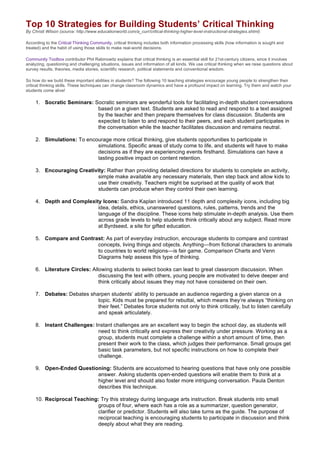
Building students’ critical thinking 10 tips
- 1. Top 10 Strategies for Building Students’ Critical Thinking By Christi Wilson (source: http://www.educationworld.com/a_curr/critical-thinking-higher-level-instructional-strategies.shtml) According to the Critical Thinking Community, critical thinking includes both information processing skills (how information is sought and treated) and the habit of using those skills to make real-world decisions. Community Toolbox contributor Phil Rabinowitz explains that critical thinking is an essential skill for 21st-century citizens, since it involves analyzing, questioning and challenging situations, issues and information of all kinds. We use critical thinking when we raise questions about survey results, theories, media stories, scientific research, political statements and conventional wisdom. So how do we build these important abilities in students? The following 10 teaching strategies encourage young people to strengthen their critical thinking skills. These techniques can change classroom dynamics and have a profound impact on learning. Try them and watch your students come alive! 1. Socratic Seminars: Socratic seminars are wonderful tools for facilitating in-depth student conversations based on a given text. Students are asked to read and respond to a text assigned by the teacher and then prepare themselves for class discussion. Students are expected to listen to and respond to their peers, and each student participates in the conversation while the teacher facilitates discussion and remains neutral. 2. Simulations: To encourage more critical thinking, give students opportunities to participate in simulations. Specific areas of study come to life, and students will have to make decisions as if they are experiencing events firsthand. Simulations can have a lasting positive impact on content retention. 3. Encouraging Creativity: Rather than providing detailed directions for students to complete an activity, simple make available any necessary materials, then step back and allow kids to use their creativity. Teachers might be surprised at the quality of work that students can produce when they control their own learning. 4. Depth and Complexity Icons: Sandra Kaplan introduced 11 depth and complexity icons, including big idea, details, ethics, unanswered questions, rules, patterns, trends and the language of the discipline. These icons help stimulate in-depth analysis. Use them across grade levels to help students think critically about any subject. Read more at Byrdseed, a site for gifted education. 5. Compare and Contrast: As part of everyday instruction, encourage students to compare and contrast concepts, living things and objects. Anything—from fictional characters to animals to countries to world religions—is fair game. Comparison Charts and Venn Diagrams help assess this type of thinking. 6. Literature Circles: Allowing students to select books can lead to great classroom discussion. When discussing the text with others, young people are motivated to delve deeper and think critically about issues they may not have considered on their own. 7. Debates: Debates sharpen students’ ability to persuade an audience regarding a given stance on a topic. Kids must be prepared for rebuttal, which means they’re always “thinking on their feet.” Debates force students not only to think critically, but to listen carefully and speak articulately. 8. Instant Challenges: Instant challenges are an excellent way to begin the school day, as students will need to think critically and express their creativity under pressure. Working as a group, students must complete a challenge within a short amount of time, then present their work to the class, which judges their performance. Small groups get basic task parameters, but not specific instructions on how to complete their challenge. 9. Open-Ended Questioning: Students are accustomed to hearing questions that have only one possible answer. Asking students open-ended questions will enable them to think at a higher level and should also foster more intriguing conversation. Paula Denton describes this technique. 10. Reciprocal Teaching: Try this strategy during language arts instruction. Break students into small groups of four, where each has a role as a summarizer, question generator, clarifier or predictor. Students will also take turns as the guide. The purpose of reciprocal teaching is encouraging students to participate in discussion and think deeply about what they are reading.
